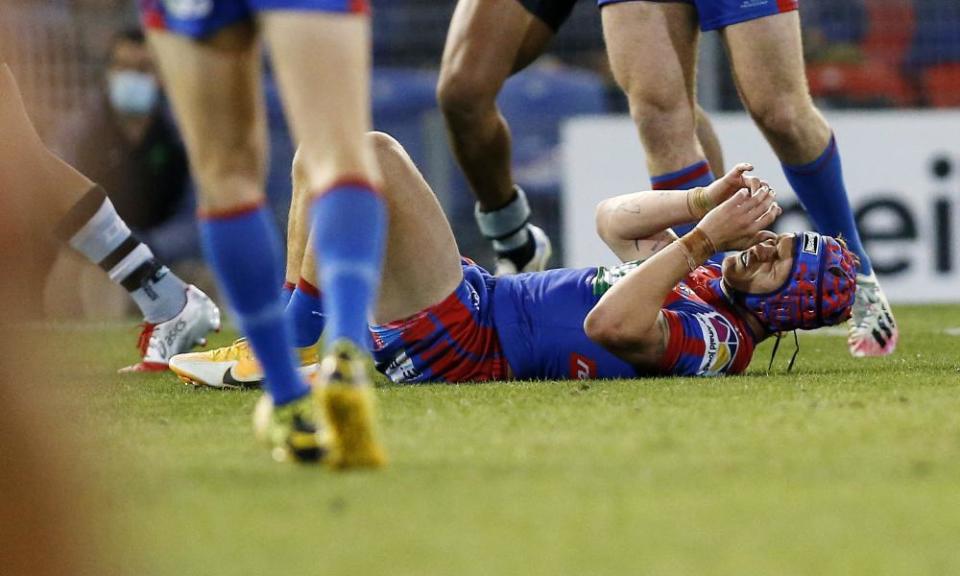NRL high shots need to disappear for the good of targeted players – and for the game itself

Rugby league has and always will be a collision sport built on courage, physicality and the innate will to overcome. The sport cannot and will not exist without its raw brutality, yet that inherent violence must be controlled to protect the game’s greatest asset: the players, and in particular its star players.
Former league boss Kevin Humphreys was the first to realise this in the 1980s. But his crusade against thuggery was not built on some intrinsic compassion for the player, rather on commercial sensibilities. The year-long suspensions and crackdown on high shots, gouging and other wanton violence was launched and then sustained to both ensure the game’s stars remained on the field and the spectacle held a wider appeal to a potential audience.
Related: Andrew Abdo handed full-time NRL CEO role after impressing during Covid shutdown
Humphreys was out of the door soon after, but the shift in the game heralded the boom Tina Turner era in the late 1980s and early 1990s. A clean game made for a more open game. Skilful stars had more opportunities to sign and tries became more prevalent. The code moved with the times while not losing its identity.
A quarter-century later, times have no doubt changed. The thirst for violence has long gone. The game is, for the most part, relatively clean, and there is a greater focus on health and professionalism. Not only are the big coathangers and eye gouges gone but so too are shoulder charges, punching, spear tackles and any number of more recently invented tackles that can hurt or maim.
Thankfully, we live in more enlightened times, where the short- and long-term safety and health of players is paramount. But we also live in more litigious times, and it is once again in the NRL’s commercial interests – as well as the interests of the players – to crack down.
There is little question that Newcastle’s Kalyn Ponga has been the subject of extra attention from opposition players. That in and of itself is not the problem; it would be an indictment on an opposition coach not to target the best players in an opposition team. That extra pepper, though, needs to come within the laws of the game.
In the Ponga situation, that is clearly not the case. Newcastle’s chief medical officer Dr Ameer Ibrahim said he is being “bashed”, “attacked” and “hit high regularly”. Targeting the head of a star opponent is not common but it is not new – Terry Lamb knocked star Balmain Tiger Ellery Hanley out early in the 1988 decider with a high shot.
Cronulla’s Chad Townsend was sent off at the weekend after launching a flying shoulder block after the whistle had blown on an unsuspecting Ponga. The shot hit him high and referee Ben Cummins rightly marched him, making him just the third player sent off this year.
Such was the damage Ponga suffered after the game, Ibrahim had to urgently mend his broken nose in the sheds afterwards to avoid emergency surgery. Ponga will miss this week, and he could have missed the remainder of the season. Townsend received just three weeks suspension.
ARLC chairman Peter V’landys and CEO have both said the right things. V’landys has declared “player protection is … paramount”. Abdo said “we will find ways to take action and better protect players”.
But the time for talk is now over following the limp penalty handed down to Townsend. The risks for the game are too high to allow him or any player to be continually hit in the head. His club doctor says there “is concern down the track”, clearly concerned about the long-term ramifications of so many high shots in a time when concussion concerns are central in collision sports. There are obvious safety concerns for players at youth and grassroots level, while the commercial impacts of potential legal challenges and the reduction of star power are large.
The league has shown an ability to stamp out play it has no desire to see and it must now make a concerted effort to ensure cheap, high and late shots on skilful players are not tolerated. There has been too much benefit of the doubt given to defenders. In a game of league, defenders are the aggressors and they are responsible for the safety of the ball carrier.
Deterrence has long proven to be the only method that works in rugby league and lengthy suspensions are the order of the day for those who lay high shots on players who are clearly being targeted. Failure to do so can have significant ramifications for the game.

 Yahoo Sport
Yahoo Sport 





































